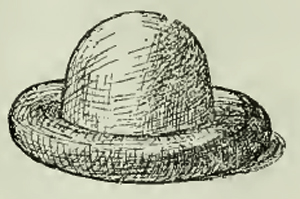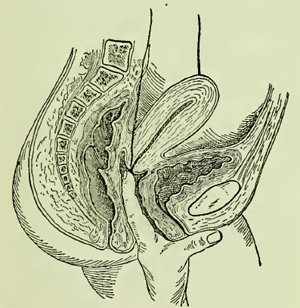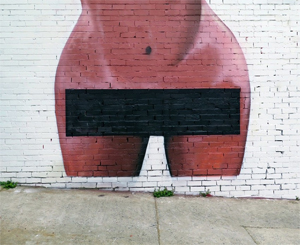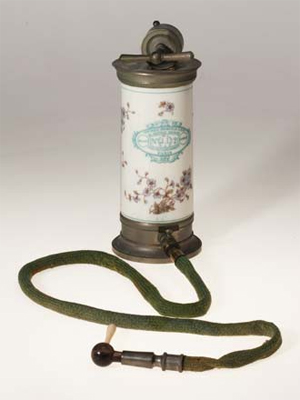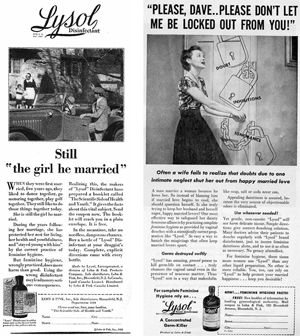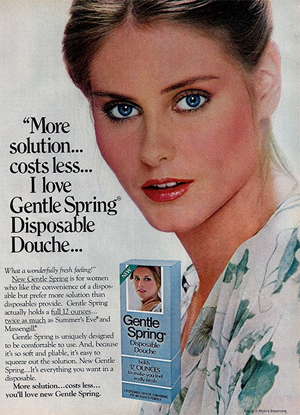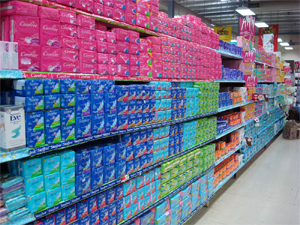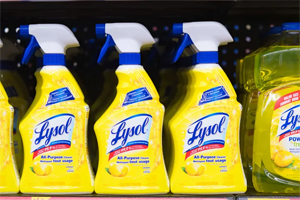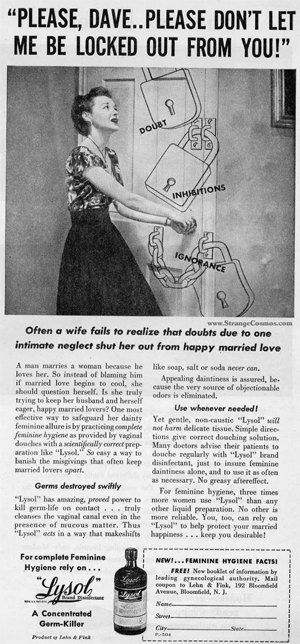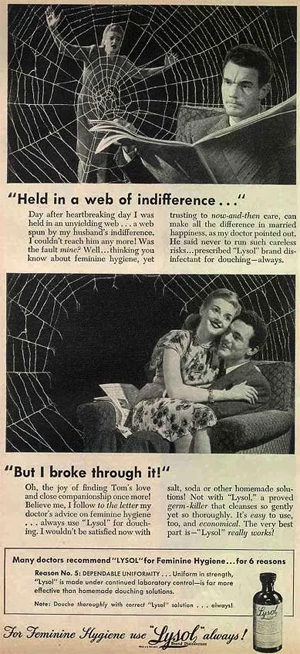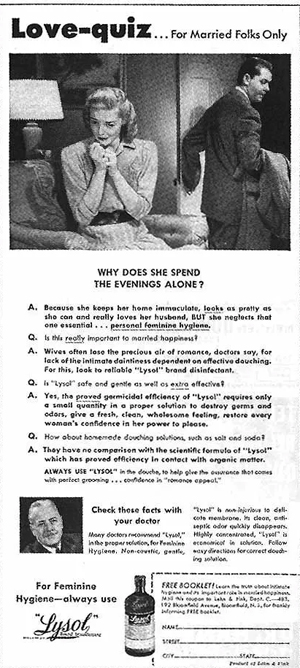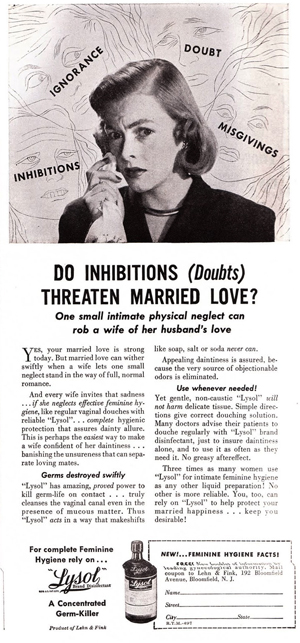Lysolby Wikipedia
Accessed: 4/2/20
The preponderance of evidence shows an association between douching and numerous adverse outcomes. Most women douche for hygienic reasons; it can be stated with present knowledge that routine douching is not necessary to maintain vaginal hygiene; again, the preponderance of evidence suggests that douching may be harmful. The authors of the present review believe that there is no reason to recommend that any woman douche and, furthermore, that women should be discouraged from douching.
-- Vaginal Douching: Evidence for Risks or Benefits to Women's Health, by Jenny L. Martino and Sten H. Vermund

Lysol
Product type: Disinfectant, all-purpose cleaners
Owner: Reckitt Benckiser
Country: U.S.
Introduced: 1889; 131 years ago
Markets: Worldwide
Previous owners: Lehn & Fink (later subsidiary of Sterling Drug)
Tagline: "Healthing"
Website:
http://www.lysol.comLysol (/ˈlaɪsɒl/ LY-sol; d.b.a. Lizol in India[1]) is a brand name of cleaning and disinfecting products distributed by the Reckitt Benckiser company. The line includes liquid solutions for hard and soft surfaces, air treatment, and hand washing. The active ingredient in many Lysol products is benzalkonium chloride, but the active ingredient in the Lysol "Power and Free" line is hydrogen peroxide. Lysol has been used since its invention in the late 19th century as a household and industrial cleaning agent, and previously as a medical disinfectant.
History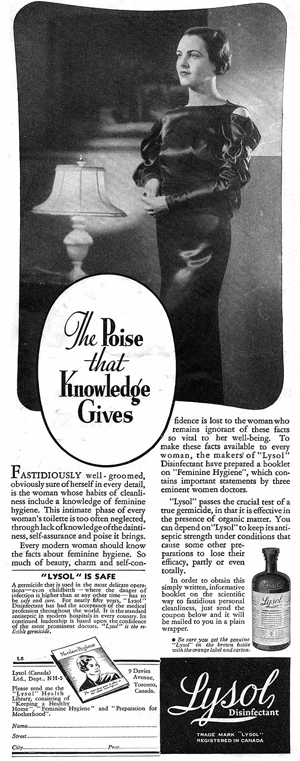 A 1935 advertisement from Canada promoting Lysol as a feminine hygiene product, using the slogan "The poise that knowledge gives"
A 1935 advertisement from Canada promoting Lysol as a feminine hygiene product, using the slogan "The poise that knowledge gives"The Poise that Knowledge Gives
Fastidiously well-groomed, obviously sure of herself in every detail, is the woman whose habits of cleanliness including a knowledge of feminine hygiene. This intimate phase of every woman's toilette is too often neglected, through lack of knowledge of the daintiness, self-assurance and poise it brings.
Every modern woman should know the facts about feminine hygiene. So much of beauty, charm and self-confidence is lost to the woman who remains ignorant of these facts so vital to her well-being. To make these facts available to every woman, the makers of "Lysol" Disinfectant have prepared a booklet on "Feminine Hygiene," which contains important statements by three eminent women doctors.
"Lysol" passes the crucial test of a true germicide, in that it is effective in the presence of organic matter. You can depend on "Lysol" to keep its antiseptic strength under conditions that cause some other preparations to lose their efficacy, partly or even totally.
In order to obtain this simply written, informative booklet on the scientific way to fastidious personal cleanliness, just send the coupon below and it will be mailed to you in a plain wrapper
Be sure you get the genuine "Lysol" in the brown bottle with the orange label and carton.
"LYSOL" IS SAFE
A germicide that is used in the most delicate operations -- even childbirth -- where the danger of infection is higher than at any other time -- has to be safe and sure. For nearly fifty years, "Lysol" Disinfectant has had the acceptance of the medical profession throughout the world. It is the standard antiseptic in modern hospitals in every country. Its continued leadership is based upon the confidence of the most prominent doctors. "Lysol" is the reliable germicide.
Lysol (Canada) Ltd., Dept., NH-5
Please send me the "Lysol" Health Library, consisting of "Keeping a Healthy Home," "Feminine Hygiene" and "Preparation for Motherhood."
Lysol Disinfectant
The first Lysol Brand Antiseptic Disinfectant was introduced in 1889 by Dr. Gustav Raupenstrauch to help end a cholera epidemic in Germany. The original formulation of Lysol contained cresols.[2]
Cresols (also hydroxytoluene) are organic compounds which are methylphenols. They are a widely occurring natural and manufactured group of aromatic organic compounds, which are categorized as phenols (sometimes called phenolics). Depending on the temperature, cresols can be solid or liquid because they have melting points not far from room temperature. Like other types of phenols, they are slowly oxidized by long exposure to air, and the impurities often give cresols a yellowish to brownish red tint.
Cresols have an odor characteristic to that of other simple phenols, reminiscent to some of a "coal tar" smell. The name cresol reflects their structure, being phenols, and their traditional source, creosote.Creosote is a category of carbonaceous chemicals formed by the distillation of various tars and pyrolysis of plant-derived material, such as wood or fossil fuel. They are typically used as preservatives or antiseptics.
Some creosote types were used historically as a treatment for components of seagoing and outdoor wood structures to prevent rot (e.g., bridgework and railroad ties, see image). Samples may be found commonly inside chimney flues, where the coal or wood burns under variable conditions, producing soot and tarry smoke. Creosotes are the principal chemicals responsible for the stability, scent, and flavor characteristic of smoked meat; the name is derived from Greek κρέας (kreas), meaning 'meat', and σωτήρ (sōtēr), meaning 'preserver'.
The two main kinds recognized in industry are coal-tar creosote and wood-tar creosote. The coal-tar variety, having stronger and more toxic properties, has chiefly been used as a preservative for wood; coal-tar creosote was also formerly used as an escharotic, to burn malignant skin tissue, and in dentistry, to prevent necrosis, before its carcinogenic properties became known. The wood-tar variety has been used for meat preservation, ship treatment, and such medical purposes as an anaesthetic, antiseptic, astringent, expectorant, and laxative, though these have mostly been replaced by modern formulations.
Varieties of creosote have also been made from both oil shale and petroleum, and are known as oil-tar creosote when derived from oil tar, and as water-gas-tar creosote when derived from the tar of water gas.[citation needed] Creosote also has been made from pre-coal formations such as lignite, yielding lignite-tar creosote, and peat, yielding peat-tar creosote.
-- Creosote, by Wikipedia
-- Cresol, by Wikipedia
This formulation may still be available commercially in some parts of the world.[3] Formulations containing chlorophenol are still available in the United Kingdom.[4]
A chlorophenol is any organochloride of phenol that contains one or more covalently bonded chlorine atoms. There are five basic types of chlorophenols (mono- to pentachlorophenol) and 19 different chlorophenols in total when positional isomerism is taken into account. Chlorophenols are produced by electrophilic halogenation of phenol with chlorine.
Most chlorophenols are solid at room temperature. They have a strong, medicinal taste and smell. Chlorophenols are commonly used as pesticides, herbicides, and disinfectants.
-- Chlorophenol, by Wikipedia
In 1911, poisoning by drinking Lysol was the most common means of suicide in Australia and New York.[5] One of the active ingredients, benzalkonium chloride, is highly toxic to fish (LC50 = 280 μg ai/L), very highly toxic to aquatic invertebrates (LC50 = 5.9 μg ai/L), moderately toxic to birds (LD50 = 136 mg/kg-bw), and slightly toxic ("safe") to mammals (LD50 = 430 mg/kg-bw).[6]Use during the 1918 Spanish flu pandemicIn 1918, during the Spanish flu pandemic, Lehn & Fink, Inc. advertised Lysol disinfectant as an effective countermeasure to the influenza virus. Newspaper advertisements provided tips for preventing the spread of the disease, including washing sick-rooms with Lysol, as well as everything that came in contact with patients. A small (US50¢) bottle made 5 US gallons (19 l; 4.2 imp gal) of disinfectant solution, and a smaller (US25¢) bottle made 2 US gallons (7.6 l; 1.7 imp gal). The company also advertised the "unrefined" Lysol F. & F. (Farm & Factory) for use in factories and other large buildings – a 5-US-gallon (19 l; 4.2 imp gal) can, when diluted as directed, made 50 US gallons (190 l; 42 imp gal) of disinfecting solution.[7]
Use as a feminine hygiene productIn the late 1920s Lysol disinfectant began being marketed as a "feminine hygiene" product by maker Lysol, Inc. and distributor Lehn & Fink, Inc. It was claimed vaginal douching with a diluted Lysol solution prevented infections and vaginal odor, and thereby preserved youth and marital bliss.[8] This Lysol solution was also used as a birth control agent, as post-coital douching was a popular method of preventing pregnancy at that time.[9] In his 1938 textbook, American obstetric physician Joseph Bolivar DeLee encouraged the use of Lysol during labor as a disinfectant: "[J]ust before introducing the hand, the vagina is liberally flushed with 1 per cent lysol solution squeezed from pledgets of cotton, the idea being to reduce the amount of infectious matter unavoidably carried into the puerperal wounds and up into the uterus by the manipulations."[10] The use of Lysol was later discouraged by the medical community as it tended to eliminate the bacteria normal to the healthy vagina, thus allowing more robust, health-threatening bacteria to thrive, and may have masked more serious problems that certain odors indicated in the first place.[11]
The Smithsonian Institution in 2013 included the Lysol feminine hygiene ads among others which were "hilarious and shocking" in hindsight.[12]
Use as an abortifacientEarlier formulations of Lysol contained cresol, a compound that can induce abortions, and it was widely used by women who could not otherwise obtain legal abortions in the United States, although the medical community was relatively unaware of the phenomenon for the first half of the 20th century.[13][14] By the 1960s, published medical literature had acknowledged the common use of Lysol and other soaps to induce abortions, which could lead to fatal renal failure and sepsis.[15]Kidney failure, also known as end-stage kidney disease, is a medical condition in which the kidneys are functioning at less than 15% of normal. Kidney failure is classified as either acute kidney failure, which develops rapidly and may resolve; and chronic kidney failure, which develops slowly. Symptoms may include leg swelling, feeling tired, vomiting, loss of appetite, and confusion. Complications of acute and chronic failure include uremia, high blood potassium, and volume overload. Complications of chronic failure also include heart disease, high blood pressure, and anemia.
-- Kidney failure, by Wikipedia
Sepsis is a life-threatening condition that arises when the body's response to infection causes injury to its tissues and organs. Common signs and symptoms include fever, increased heart rate, increased breathing rate, and confusion. There may also be symptoms related to a specific infection, such as a cough with pneumonia, or painful urination with a kidney infection. The very young, old, and people with a weakened immune system may have no symptoms of a specific infection, and the body temperature may be low or normal instead of having a fever. Severe sepsis is sepsis causing poor organ function or blood flow. The presence of low blood pressure, high blood lactate, or low urine output may suggest poor blood flow. Septic shock is low blood pressure due to sepsis that does not improve after fluid replacement.
-- Sepsis, by Wikipedia
Use during the 2020 coronavirus pandemicGiven its popularity as a disinfectant, Lysol has had a major ongoing role in household and medical sanitation throughout the COVID-19 pandemic. Several of Lysol's products are on the EPA's list of registered disinfectants: Lysol brand Heavy-Duty Cleaner Disinfectant Concentrate, Lysol Disinfectant Max Cover Mist, and Lysol brand Clean & Fresh Multi-Surface Cleaner.[16]
Product innovations• 1930: Lysol Brand Disinfectant Liquid was introduced to drug stores and hospitals.
• 1957/58 Lysol purchased the rights to private label National Laboratories, Inc's Disinfectant spray.
• 1962: Lysol released the Lysol Disinfectant Spray, which used a new method of aerosol application.
• 1968: Lysol began creating bathroom cleaners and released the Lysol Toilet Bowl Cleaner.
• 1985: Lysol All Purpose Cleaner was released.
• 1988: Lysol began shipping aerosol disinfectants to humid areas such as Houston, to combat "lung rot".
• 2000: Lysol introduced Lysol Disinfecting Wipes, pre-moistened cleaning wipes for use on hard, non-porous surfaces.
• 2009: Lysol began producing hand soaps.
Ownership: Lehn & Fink was acquired by Sterling Drug in 1967 and Reckitt & Colman acquired L&F in 1994 when Bayer acquired Sterling-Winthrop. As of 2015 Lysol products were distributed by Reckitt Benckiser LLC of Parsippany, New Jersey.
IngredientsDifferent Lysol products contain different active ingredients. Examples of active ingredients used in Lysol products:
• Ethanol/SD Alcohol, 40 1–3%; fluid that acts as sanitizer
• Isopropyl alcohol, 1–2%; partly responsible for Lysol's strong odor; acts as sanitizing agent and removes odor
• p-Chloro-o-benzylphenol, 5–6%; antiseptic
• o-Phenylphenol, 0.1%; antiseptic; in use circa 1980s
• Potassium hydroxide, 3–4%
• Alkyl (50% C14, 40% C12, 10% C16) dimethylbenzyl ammonium saccharinate, 0.10%; microbiocide
• Alkyl (C12-C18) dimethylbenzylammonium chloride, 0.08%; antiseptic
• Alkyl (C12-C16) dimethylbenzylammonium chloride, 0.02%; antiseptic
• Lactic acid as an antiseptic.
• Hydrogen Peroxide
Products• Disinfectants: Lysol Disinfectant products are used to kill surface and air bacteria. Products include:
o Lysol Disinfectant Spray
o Lysol Disinfecting Wipes
o Lysol Concentrate Disinfectant
• Cleaners: Lysol distributes several multi-purpose cleaners, kitchen cleaners, and bathroom cleaners. These include:
o Lysol Power & Free
o Lysol All-Purpose Cleaner
o Lysol Multi-Surface Cleaner Pourable
o Lysol Power Kitchen Cleaner
o Lysol Bathroom Cleaner
o Lysol Toilet Bowl Cleaner
o Lysol Mold & Mildew Remover
• Hand Soaps: Lysol recently developed a line of disinfecting hand soaps. Products include:
o Lysol No Touch Hand Soap System
o Lysol Touch of Foam Hand Wash
CompetitionLysol's major competitors include Lysoform, Clorox, Febreze, Oust, Mr. Clean, Cif, Pine-Sol, OxiClean, Simple Green, Domestos and Tilex.
References1. "Media Corner." Lyzol India, 20 September, 2006. Accessed January 13, 2020.
2. SIMMONS, W.H. (1908). THE HANDBOOK OF SOAP MANUFACTURE no. SCOTT, GREENWOOD & SON.
3. "Disinfectant, Disinfectants, antiseptics and disinfectants". GMP Chem Tech Pvt. Ltd., India. Retrieved 22 April 2008."Material Safety Data Sheets (L)". ReSource Colorado (a full service flooring contractor). Retrieved 22 April 2008.
4. "Material Safety Data Sheet, Lysol(R) Brand Concentrate, Original Scent" (PDF). 18 April 1997. Retrieved 22 April 2008.
5. "LYSOL POISONING". Melbourne (Australia) Argus (newspaper). 10 January 1912. Retrieved 7 May 2013.
6. Frank T. Sanders, ed. (August 2006). Reregistration Eligibility Decision for Alkyl Dimethyl Benzyl Ammonium Chloride (ADBAC) (PDF) (Report). U.S. Environmental Protection Agency Office of Prevention, Pesticides, and Toxic Substances. p. 114. Archived from the original (PDF) on 24 October 2009. Retrieved 31 March 2009.
7. "Fight Spanish Influenza With Daily Disinfection" (advertisement). The New York Times. 30 October 1918, p. 9. (Accessed via ProQuest, New York Times (1857–Current file), Document ID 97039401)
8. "Lysol Douche Advertisements". 26 August 2005. Retrieved 19 July 2016.
9. Sanger, Margaret H. Family Limitations, Sixth Edition. 1917. Accessed January 13, 2020.
10. DeLee, Joseph B., A.M., M.D. The Principles and Practice of Obstetrics. 7th ed. Philadelphia: W. B. Saunders Company, 1938, p. 319.
11. Finley, Harry. "Lysol douche ad, 1928, U.S.A.". The Museum of Menstruation and Women's Health, 1998. Accessed 22 March 2007.
12. Eveleth, Rose (30 September 2013). "Lysol's Vintage Ads Subtly Pushed Women to Use Its Disinfectant as Birth Control". smithsonianmag.com. Retrieved 2 February 2015.
13. Flanagan, Caitlin (December 2019). "The Dishonesty of the Abortion Debate." The Atlantic. Accessed January 13, 2020.
14. Presley, J. A.; Brown, W. E. (September 1956). "Lysol-Induced Criminal Abortion". Obstetrics & Gynecology. 8 (3): 368–370. Retrieved 14 January 2020.
15. Bartlett, Robert H.; Yahia, Clement (2 October 1969). "Management of Septic Chemical Abortion with Renal Failure: Report of Five Consecutive Cases with Five Survivors". The New England Journal of Medicine. 281 (14): 747–53. doi:10.1056/nejm196910022811401. PMID 5807922.
16. Zdanowicz, Christina. "Here's a list of disinfectants you can use against coronavirus". CNN. Retrieved 30 March 2020.
External links• Official website


